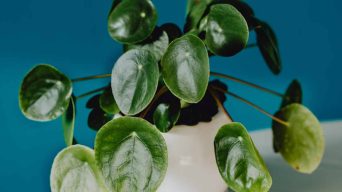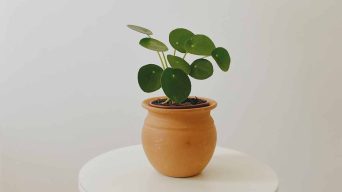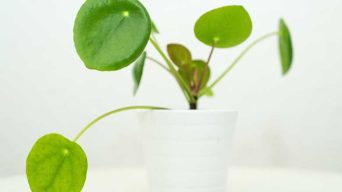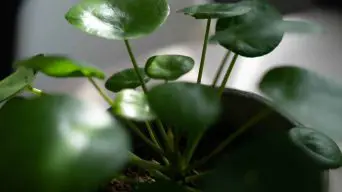Key Takeaways
- Overwatering and poor soil quality are common reasons a Pilea plant may be dying, so it’s essential to establish proper watering habits and use well-draining soil when caring for these plants.
- Pest infestations such as mealybugs and spider mites can also cause a Pilea plant to decline rapidly. Inspect your plants regularly for signs of pest problems, treating them promptly with insecticidal soap or neem oil spray and isolating infected plants if necessary.
- Adjusting lighting conditions, trimming away damaged leaves, and repotting with fresh soil are effective solutions to revive a dying Pilea Peperomioides plant.
Pilea Peperomioides, also known as the Chinese Money Plant or Friendship Plant, is a popular houseplant prized for its round pancake-like leaves and minimal care requirements.
However, seeing your once-thriving pilea suddenly start drooping or showing signs of distress can be frustrating.
Here, we will explore the common reasons why your pilea may die and provide practical solutions to save your beloved plant.
Signs Of A Dying Pilea Plant
If your Pilea plant is dying, you may notice signs such as yellow or brown leaves, drooping stems, root rot, or pest infestations.
1. Yellowing Or Browning Leaves
One of the most noticeable signs that your Pilea plant is struggling is when its leaves turn yellow or brown.
This color change may be accompanied by curling edges, spotted patterns, or leaf drop.
These symptoms often indicate issues with soil moisture, such as overwatering or underwatering.
To address this issue, assess your watering habits and ensure you provide the appropriate amount of moisture for your Pilea plant.
Monitor the soil’s dampness by sticking your finger about an inch into it; ideally, wait until it feels dry before watering again.
Be sure to use well-draining pots with drainage holes to prevent standing water around the bottom of the roots – consistently wet conditions can lead to root rot and worsen the problem.
2. Drooping Or Wilting
Drooping or wilting leaves on a Pilea plant can be quite disheartening for any plant owner, as it is often one of the first noticeable signs that something is amiss.
A common cause of drooping in Pilea plants is overwatering, which leads to root rot and hinders the ability of roots to deliver essential nutrients and water throughout the plant.
Pay close attention to other factors that may lead to drooping or wilting leaves on your beloved Pancake plant.
Inadequate lighting conditions or low humidity levels can stress out a Pilea peperomioides, causing it to lose its vigor and vitality.
Moreover, pest infestations like spider mites and aphids might also wreak havoc on your indoor plant’s well-being by extracting vital fluids from its tissues.
3. Root Rot
Root rot is a common issue that can cause your Pilea plant to decline rapidly, often resulting in the death of the beloved houseplant.
This condition occurs when overwatering or poor drainage creates an environment where fungi thrive, attacking and damaging the roots of your precious plant.
As these essential structures decay, your Pilea’s ability to absorb nutrients and water becomes compromised.
To avoid root rot in your Pilea peperomioides, also known as ufo plant or pancake plant, it’s crucial to establish proper watering habits while using well-draining soil that allows excess water to pass through easily.
Ensure you let the top inch of soil dry out between each watering session – this helps maintain optimal moisture levels for a healthy root system.
Common Reasons Why A Pilea May Be Dying
If you notice that your Pilea plant is dying, there are a few common reasons why this might be happening.
These include overwatering or underwatering, poor soil quality, lack of sunlight, pest infestation, and diseases.
1. Overwatering
One of the most common mistakes when caring for a Pilea plant is overwatering.
This occurs when the soil remains consistently wet, leading to root rot and oxygen deprivation in the roots.
To prevent overwatering your Pilea, it’s crucial to let the top inch of soil dry out before watering again.
Consider using well-draining soil and ensuring that your pot has good drainage holes to allow excess water to escape.
Regularly inspect your plant for signs of damage caused by excess moisture, such as brown spots on leaves or soggy soil.
2. Underwatering
If your Pilea plant isn’t getting enough water, it may wither and look lifeless.
Underwatering is a common issue that can lead to yellowing or browning of the leaves and leaf loss.
If the top inch of soil feels dry, it’s time to give your plant a good soak.
When watering, thoroughly until water drains from the pot’s drainage hole.
This helps ensure that all roots receive enough moisture while preventing overwatering.
3. Poor Soil Quality
Pilea plants require nutrient-rich soil for healthy growth and development.
Poor potting soil quality can lead to stunted growth, yellow or brown leaves, and other problems that affect the overall health of your plant.
One common issue is using heavy clay or compacted soil that doesn’t allow water to drain properly, leading to root rot.
To avoid poor soil quality issues in your Pilea plant, use a well-draining potting mix when repotting or planting new plants.
Also, consider mixing in some perlite or sand to help improve drainage even further.
Additionally, consider changing the soil every year or two to replenish nutrients and remove any compacted matter from the topsoil layer.
4. Lack Of Sunlight
A lack of sunlight is one of the most common reasons a Pilea plant may die.
Often, this is due to placing the plant in a location with insufficient light or needing to provide more light for the duration required each day.
Leggy and stretched stems and leaves indicate that your Pilea plant isn’t getting enough sunlight.
This typically happens when it’s placed too far away from windows or blocked by other objects, such as curtains, furniture, or other plants.
To avoid this problem, ensure your Pilea can access bright indirect light throughout the day since direct sunlight can harm its delicate leaves.
A great way to provide your plants with the optimal amount of light is to place them near a window that allows for about six hours of bright but indirect sunlight daily while keeping them out of harsh afternoon sun rays.
This can be achieved by positioning the window so that the sun’s rays are diffused and not directly hitting the plants.
5. Fertilizer Burn
Overfertilization can be a common cause of why a Pilea plant might die, leading to fertilizer burn.
It happens when there are excessive nutrients in the soil due to too much fertilizer use.
Symptoms of fertilizer burn include brown or yellow spots on leaves and leaf tips turning black or wilted.
To prevent fertilizer burn, follow the instructions on the label carefully when applying fertilizers – always use as directed.
When temperatures are extreme, such as during heat waves or droughts, it is essential to avoid fertilizing your Pilea, as high temperatures can cause stress and lead to nutrient burn if used as directed.
6. Pest Infestation
Pest infestation is one of the leading causes of Pilea plant death. Mealybugs, spider mites, and scale insects are common pests that can attack your Pilea peperomioides plant.
These pests suck sap from leaves, causing yellowing or browning of leaves and stunted growth.
To save your Pilea plant from pest infestation, use an insecticidal soap or neem oil spray to kill the bugs. Also, isolate any infected plants to prevent spreading to other healthy plants in your collection.
7. Diseases
Another possible reason your Pilea plant may not thrive is due to diseases.
Pileas are susceptible to various diseases, such as mildew and leaf spot. Mildew appears as a white powdery substance on the leaves, while leaf spot manifests as brown or black spots on the foliage.
Removing any affected leaves and isolating the plant until you’ve addressed the issue is essential to prevent these diseases from spreading.
You can also reduce watering frequency and increase airflow around your Pilea plant.
How To Save A Dying Pilea Plant
If you want to revive a Pilea Peperomioides plant that is dying, you can take several steps, such as changing the watering schedule, repotting with fresh soil, removing damaged leaves, treating pests, and adjusting the lighting conditions.
1. Adjust Watering Habits
One of the most common reasons why Pilea Peperomioides plants die is due to overwatering.
It’s important to allow the top inch of soil to dry out before watering again, as this will prevent root rot and other issues.
Use a moisture meter or stick your finger into the soil to adjust your watering habits to check for dampness.
Hold off on watering until it dries out slightly if it feels moist.
Additionally, ensure that your pot has good drainage holes so excess water can escape, and avoid letting water sit in a saucer below the plant.
2. Repot With Fresh Soil
If your Pilea Peperomioides is struggling and you’ve ruled out overwatering or pests as a cause, it may be time to repot.
Over time, the soil can become depleted of nutrients and compacted, making it difficult for the plant to absorb water and fertilizers.
To repot your Pilea, choose a pot slightly larger than its current one but not too big since excess soil can lead to waterlogging.
Choose a well-draining potting mix that will provide essential nutrients while allowing excess moisture to exit quickly.
Gently remove the plant from its old container, carefully removing any delicate roots.
Carefully loosen up any clumps of soil around the roots before positioning them in their new home and filling in with fresh soil.
Refreshing your Pilea’s soil regularly with fresh potting mix every year or two instead of just topping them off with more dirt does wonders for these plants’ growth because they thrive on nutritious soils rich in organic matter.
3. Trim Away Damaged Leaves
Trimming away damaged leaves is essential in saving a dying Pilea peperomioides.
When leaves turn yellow or brown, they may suffer from overwatering and root rot.
Trimming these leaves helps redirect the plant’s energy towards healthy growth instead of wasting efforts on sick leaves.
If your Pilea’s leaves have been affected by pest infestations, it is important to trim them to prevent the spread of infection and further sick leaves.
Spider mites are one common pest for Pileas, which suck out sap from the plant’s foliage leading to damage and weakening of stems.
If symptoms persist even after controlling pests, consider trimming off damaged sections of the plant entirely for better chances of revival.
4. Treat For Pests
Pest infestations can be one of the main reasons your Pilea plant is dying.
Signs of pest problems include brown spots, curled leaves, and discoloration.
The good news is that you can easily treat this issue using natural remedies such as neem oil or diatomaceous earth.
To use neem oil as a treatment method for pests, mix it with water in a spray bottle and apply it to both sides of the leaves and stems.
For diatomaceous earth, sprinkle it around the base of your Pilea to deter crawling insects from approaching the plant.
5. Adjust Lighting Conditions
Proper lighting is crucial for the growth and health of your Pilea peperomioides.
To ensure optimal health for your Pilea peperomioides, it is important to find an area with bright, indirect light, avoiding direct sunlight, as this can cause the leaves to become scorched.
If your Pilea looks leggy or drooping, it may be a sign that it’s not getting enough light.
On the other hand, if you notice brown spots on the leaves or excessive leaf loss, your plant may be getting too much direct sun.
When placing your houseplant in a spot with more filtered light, you may want to consider adding a sheer curtain to provide shade and diffuse the sun’s harsh rays.
Remember that these plants prefer consistent lighting conditions, so avoid sudden changes in exposure if possible.
Prevention Tips For Keeping Your Pilea Healthy
To ensure the health and prosperity of your Pilea plant, it’s important to use soil that drains well, avoid excessive fertilization, monitor watering frequency, ensure sufficient sunlight, and regularly inspect and clean the plant.
Use Well-draining Soil
One of the most essential factors in ensuring a healthy Pilea plant is to use well-draining soil.
This soil type allows water to seep quickly, preventing excess moisture that can lead to root rot and other problems.
Using well-draining soil also helps prevent fertilizer buildup by allowing excess nutrients to leach out with watering.
Aeration is crucial for the health of plants’ roots, so make sure there are enough air pockets within the soil mixture by adding perlite or vermiculite if necessary.
Avoid Overfertilizing
When it comes to fertilizing your Pilea Peperomioides, less is often more. Over-fertilization can be as harmful as underwatering or overwatering your plant, leading to yellowing leaves and stunted growth.
One common mistake plant owners make is assuming that regular fertilizer applications will lead to bigger and healthier plants.
However, this approach can do more harm than good.
Instead, focus on providing appropriate watering conditions and adequate sunlight while using a balanced potting mix that contains all essential nutrients for proper growth.
Just remember to fertilize during the growing season to give your Pilea the right amount of nutrients.
Monitor Watering Habits
Proper watering is one of the most crucial factors in keeping your Pilea healthy.
Overwatering can cause root rot and yellowing leaves, while underwatering can lead to leaf loss and a generally unhappy plant.
Monitoring the soil moisture regularly and only water when needed is essential.
If you need help determining how often to water your plant, create a watering schedule based on environmental factors like temperature and humidity levels.
Additionally, consider using pots with drainage holes or adding perlite or sand to improve soil drainage.
Provide Adequate Sunlight
One thing that can significantly impact the health of your Pilea is sunlight. While these plants thrive in bright, indirect light, too much or too little can cause problems.
To ensure healthy plant growth, it is essential to strike a balance between direct and indirect light, as too much of either can lead to negative consequences; too much indirect light will result in yellowed leaves and stunted growth, while direct, intense light can lead to dehydration and burnt leaves.
If you notice signs of sunburn on your Pilea plant, including brown spots or crispy edges on its leaves, move it away from windows with direct sunlight.
Regularly inspecting the condition of your plant’s foliage is essential for tracking how well they are fairing under their current lighting environment.
Regularly Clean And Inspect The Plant
One of the best ways to prevent various issues that may cause your Pilea to die is through regular cleaning and inspection of the plant.
Dust can accumulate on the leaves and interfere with photosynthesis, so wiping them down regularly using a soft cloth or sponge is essential to maintain the health of the stem and leaves.
Also, inspecting your plant can help you catch any problems early before they get out of hand.
Look for signs such as yellowed lower leaves or brown spots on upper foliage, which may indicate overwatering or poor soil quality.
Remember that spotting issues early is key when saving a dying plant!
A few minutes per week spent cleaning and inspecting your green friend could save it from death in the long run!
How To Revive A Severely Damaged Pilea Plant
Keep hope if your Pilea Peperomioides plant is badly damaged. There are still ways to bring it back to life.
Keep reading for some helpful tips and tricks.
Cut Back The Plant
If your Pilea peperomioides is severely damaged, cutting back the plant may be necessary to save it.
This can involve trimming away dead or diseased leaves and stems so that the remaining healthy parts of the plant can focus on regenerating growth.
Once you have cut back and cleaned up the plant, give it time to recover in a favorable environment with ample light and proper watering habits.
During this period, monitor your Pilea’s growth and make adjustments to ensure it continues thriving over time.
Propagate Healthy Stems
If your Pilea Peperomioides has suffered significant damage, propagating healthy stems might be the best course of action to save your plant.
Propagation is a simple and effective way to increase your collection or replace damaged plants with new ones.
To propagate healthy stems from your Pilea Peperomioides, identify any healthy-looking stems with at least two leaves attached and cut them cleanly just below the third leaf node.
Keep the soil moist by watering it lightly until fresh growth emerges above the surface, which usually takes a few weeks.
Eventually, roots will develop from beneath the surface, thus producing an entirely new plant that resembles its parent.
Growing multiple Pilea Peperomioides provides extra decor and insurance against losing an entire plant due to disease or pest infestation.
Adjust Growing Conditions
One effective way to save a dying Pilea peperomioides is by adjusting its growing conditions.
This could involve changing watering habits, providing more or less sunlight exposure, or even repotting the plant with fresh soil.
Overwatering is a common problem that can lead to root rot and other issues, so allowing the top inch of potting medium to dry out before watering again is essential.
On the other hand, if your plant appears wilted and limp, it may be thirsty and need more frequent watering.
Additionally, make sure your Pilea peperomioides receive adequate bright indirect light – not too much direct sun – as this promotes healthy growth while avoiding leaf damage.
Final Thoughts
Several common reasons your Pilea plant may die include overwatering, poor potting soil quality, lack of sunlight, and pest infestations.
Fortunately, there are several solutions available to save your houseplants!
Adjusting watering habits and repotting with fresh soil can make a big difference in reviving your Pilea.
It’s also important to regularly clean and inspect the plant for pests.







